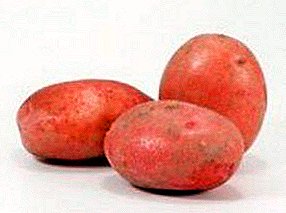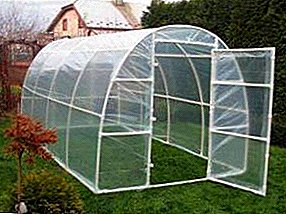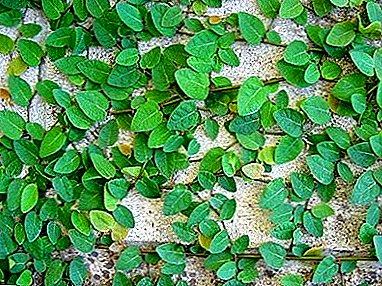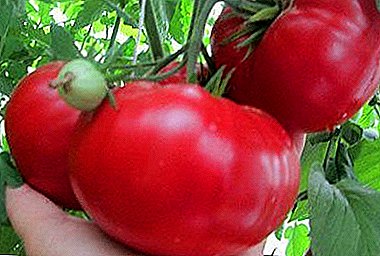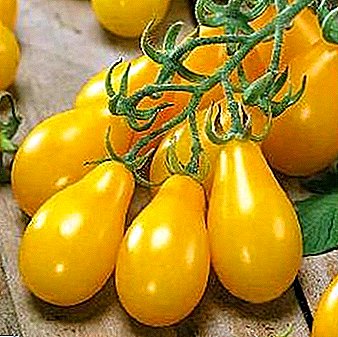
Lianovidnye tomatoes with small bright fruits - a real decoration of the garden or greenhouse. These varieties of tomatoes are very fruitful, resistant to pests, rarely affected by viruses or fungi. In addition, their fruits are very tasty.
The popular variety of tomato Honey Drop is a bright representative of this variety. You can find out more about it in our article. Read the full description of the variety, the characteristics of its cultivation and the main characteristics.
Honey Drop Tomato: variety description
| Grade name | Honey Drop |
| general description | Mid-season indeterminantny grade |
| Originator | Russia |
| Ripening | 110-115 days |
| The form | Pear-shaped |
| Colour | Yellow |
| Average tomato mass | 10-30 grams |
| Application | Universal |
| Yield varieties | 6 kg from a bush |
| Features of growing | Agrotechnika standard |
| Disease resistance | Resistant to many diseases |
 The grade is removed in Russia, intended for cultivation in the greenhouse. In regions with warm and long summer, it is possible to plant in open ground, in temperate climates, the formed ovaries will not have time to mature. Tomatoes Honey Drop - medium early small-fruited variety.
The grade is removed in Russia, intended for cultivation in the greenhouse. In regions with warm and long summer, it is possible to plant in open ground, in temperate climates, the formed ovaries will not have time to mature. Tomatoes Honey Drop - medium early small-fruited variety.
Indeterminate bushes, not standard, reach 2 m in height, require strong supports, tying and pasynkovaniya. The large leaves of the tomato are similar to the potato ones. The fruits are collected in clusters of 10-15 pieces. Fruiting lasts from mid-summer to late September.
Among the main advantages of the variety:
- high seed germination (up to 95%);
- excellent taste of the fruit;
- Tomatoes are suitable for canning and fresh consumption;
- excellent yield;
- reproduction by seeds collected from fully ripe fruit is possible.
Gardeners, who have already tested the variety, point out some disadvantages:
- tall bushes require careful pinching;
- tomatoes need a strong support;
- increased requirements for soil composition, fertilizer and irrigation.
You can compare the yield of a variety with others in the table:
| Grade name | Yield |
| Honey Drop | 6 kg from a bush |
| Sugar cream | 8 kg per square meter |
| Friend F1 | 8-10 kg per square meter |
| Siberian early | 6-7 kg per square meter |
| Golden stream | 8-10 kg per square meter |
| Pride of Siberia | 23-25 kg per square meter |
| Leana | 2-3 kg from a bush |
| Miracle lazy | 8 kg per square meter |
| President 2 | 5 kg from a bush |
| Leopold | 3-4 kg from a bush |
Specifications
The fruits are small, weighing from 10 to 15 g, individual specimens can reach 30 g. Tomatoes have an original pear-shaped shape, resembling an amber drop. The color is deep yellow, bright. Taste is pleasant, sweetish, with light honey notes.. Tomatoes are very juicy, the inner chambers are small, with a moderate amount of seeds. Sugar content close to the maximum, these tomatoes are very fond of children.
Beautiful and juicy fruits can be eaten fresh, used to make salads, side dishes, soups, juices. Tomatoes are suitable for canning, especially in combination with other small varieties of red or orange flowers.
Compare the weight of fruit varieties with others can be in the table:
| Grade name | Fruit weight |
| Honey Drop | 10-30 grams |
| Alpatieva 905A | 60 grams |
| Pink flamingo | 150-450 grams |
| Tanya | 150-170 grams |
| Apparently invisible | 280-330 grams |
| Early love | 85-95 grams |
| The baron | 150-200 grams |
| Apple Russia | 80 grams |
| Valentine | 80-90 grams |
| Katya | 120-130 grams |
A photo
Tomatoes (tomatoes) “Honey Drop” are bright and beautiful, then you can see their photos:


Features of growing
Sredneranny grade the Honey Drop tomato is recommended to be sowed in the beginning of March. For sowing, seeds suitable for 2-3 years of aging, they have a maximum germination rate (95-96%). Seeds can be purchased or harvested on their own, using fruits in the phase of physiological ripeness. The collected seeds must be disinfected before sowing, soaking in an aqueous solution of potassium permanganate or hydrogen peroxide.
Lightweight nutrient ground needed for seedlings from a mixture of garden earth, humus, sand or vermicult. Before sowing the soil is decontaminated. A small amount of superphosphate and potassium fertilizers is added to the soil mixture.
 Seeds are sown with a slight deepening, germinate them preferably under the film. The optimum temperature for planting - 22-25 degrees. Crops require careful watering with warm settled water and double feeding with complex or mineral fertilizers..
Seeds are sown with a slight deepening, germinate them preferably under the film. The optimum temperature for planting - 22-25 degrees. Crops require careful watering with warm settled water and double feeding with complex or mineral fertilizers..
In the unfolding phase of 2 true leaves, young plants dive into separate pots. When picking, it is recommended to pinch the main root to stimulate the development of smaller ones. Be sure to hardening, preparing seedlings for transplanting to a permanent place of residence. Seedlings carried out to fresh air, leaving for several hours. For the successful development of seedlings requires bright sunlight, in cloudy weather, seedlings are illuminated with electric lamps.
In the greenhouse seedlings can be transplanted in the first half of May. In open ground, seedlings are placed later, in late May or early June. Optimal distance between bushes - 40-45 cm, with a distance between rows of 70 cm. When grown in the soil is recommended to cover young plants with a film.
Tomatoes "Honey Drop" are very demanding on the quality of the soil, the top layer of soil in the greenhouse is replaced annually. Do not plant tomatoes in a place where eggplants or peppers were already growing. It is advisable to plant them on the beds that occupied cabbage, legumes or spicy greens.
Read more about the soil for seedlings and for adult plants in greenhouses. We will tell you about what types of soil for tomatoes exist, how to prepare the right soil on your own and how to prepare the soil in the greenhouse in spring for planting.
After planting bushes must be tied to a support. In a greenhouse, vines reach two meters in length, so they are best grown on trellis, horizontal or vertical. In the open field, tomatoes grow up to 1.5 m, they can be attached to the grid or long stakes. Shrubs form into two or three stems, constantly removing the side stepsons. If this is not done, the tomato plantation will turn into a thick thicket, and the fruits will be tied worse.
Water the tomatoes need warm water, no more than 1 time in 6 days. The greenhouse must be constantly aired, the variety does not like too humid air. Weekly, the soil under the tomatoes is loosened, at the same time destroying weeds. Feed bushes 1 time in 2 weeks, alternately introducing aqueous solutions of complex mineral and organic fertilizers. After the formation of ovaries, it is necessary to feed the bushes with potash fertilizers, stimulating the early ripening of fruits.
 On our site you will find a lot of useful information on how to grow tomato seedlings. Read all about planting seedlings at home, how long after planting the seeds emerge and how to water them properly.
On our site you will find a lot of useful information on how to grow tomato seedlings. Read all about planting seedlings at home, how long after planting the seeds emerge and how to water them properly.And also how to grow tomatoes in a twist, upside down, without land, in bottles and according to Chinese technology.
Diseases and pests
The variety is resistant to the main diseases of Solanaceae: late blight, blackleg, gray rot. However, the neighborhood with other tomatoes can cause infection of the bushes. This phenomenon is more often noticed in greenhouses and small greenhouses, where plants are planted closely. It is noticed that in an open ground tomatoes are ill less often.
As a preventive measure, it is recommended to carefully cultivate the soil before planting seedlings, mulching the soil with peat or straw, as well as frequent spraying with non-toxic antifungal and antiviral preparations, for example, phytosporin. It is important not to flood the plants during watering and make sure that the air in the greenhouse is not excessively humid.
Frequent airing, soil mulching and spraying the bushes with an aqueous solution of hydrogen peroxide or celandine will protect against insect pests. From aphids helps solution of water and laundry soap, which gently treated the affected bushes.
Conclusion
Honey Drop is an interesting and original variety that is worth growing on the site. It is suitable for industrial breeding in farms. Tasty and elegant fruits will decorate the holiday table, suitable for baby food and canning. All gardeners who have made a choice in favor of this variety are no longer abandoning it, annually planting at least a few bushes.
| Mid-season | Medium early | Late-ripening |
| Anastasia | Budenovka | Prime minister |
| Raspberry wine | Mystery of nature | Grapefruit |
| Royal gift | Pink king | De Barao the Giant |
| Malachite Box | Cardinal | De barao |
| Pink heart | Grandma's | Yusupovskiy |
| Cypress | Lev Tolstoy | Altaic |
| Raspberry giant | Danko | Rocket |




